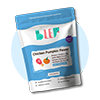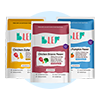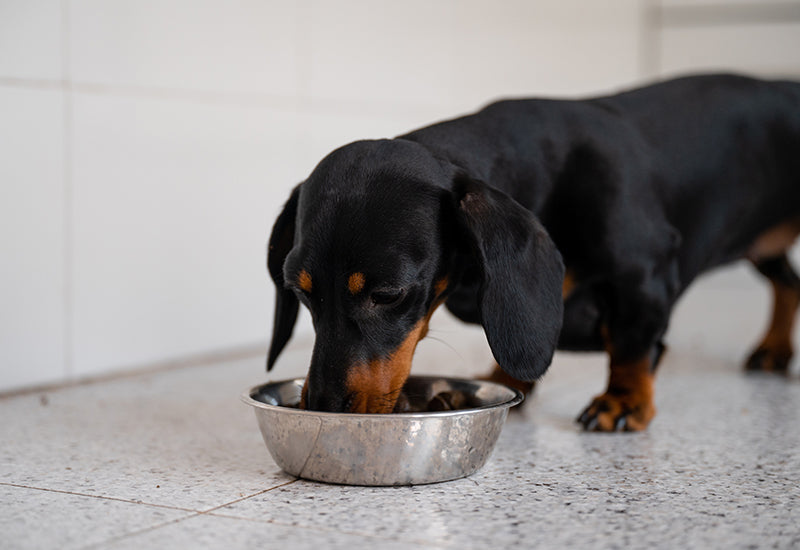The debate over feeding dogs raw or cooked meat has been ongoing, and both approaches have their proponents and critics. It's important to note that the choice between raw and cooked meat for dogs often depends on various factors, including the dog's health, age, and individual preferences.
Factors that play an essential role –
1. Health Conditions:
- Dogs with certain health conditions, such as a compromised immune system or a history of digestive issues, may benefit from cooked meat. Cooking helps eliminate potential pathogens, reducing the risk of foodborne illnesses that could be particularly harmful to dogs with weakened immune systems.
- On the other hand, some people who support feeding dogs raw food say that it can help dogs with certain health problems, like allergies or skin issues. However, this approach should be approached cautiously and in consultation with a veterinarian.
2. Age:
- Puppies, elderly dogs, or dogs with dental issues may find consuming and digesting cooked meat easier. The cooking process softens the meat, making it more palatable and accessible, especially for dogs with dental concerns.
- Some raw feeding advocates argue that a raw diet resembles what a dog's ancestors would have eaten in the wild, which might benefit a dog of any age. However, the transition to a raw diet should be done gradually, and considerations should be made based on the dog's developmental stage.
3. Individual Preferences:
- Some dogs have individual preferences regarding the texture and taste of their food. Some may prefer the taste of raw meat, while others may find cooked options more appealing.
- It's essential to observe a dog's behavior and preferences and be willing to adapt the diet to suit their individual tastes. This may involve experimenting with raw and cooked options to see what the dog enjoys and tolerates best.
4. Dietary needs
- Dogs require specific types and amounts of food depending on their breed, size, how active they are, and how healthy they are overall.
- Each dog's diet should be tailored to meet these specific needs for their well-being. Both raw and cooked diets can be formulated to meet these specific requirements.
- A balanced diet is crucial, regardless of whether the meat is served raw or cooked. Ensuring the dog receives nutrients, vitamins, and minerals supports overall health and well-being.
What do you mean by raw meat for dogs?

Raw meat for dogs" refers to uncooked, minimally processed meat intended for canine consumption. Dogs can enjoy various meats, such as beef, chicken, turkey, lamb, and more as part of their meals. Raw meat diets for dogs often mimic what canines may have eaten in the wild before the advent of commercial pet food.
A raw meat diet typically includes muscle meat, bones, and organs. Some proponents of raw feeding argue that this approach provides dogs with a more natural and biologically appropriate diet, as it closely resembles what their ancestors might have eaten in the wild. However, it's important to note that feeding dogs raw meat has supporters and critics within the veterinary and pet care communities.
Pros and Cons of Raw Meat
Pros:
1. Nutrient retention: Proponents argue that raw meat retains more nutrients, enzymes, and natural enzymes than cooked meat.
2. Dental health: Chewing on raw bones helps dogs have better teeth by preventing the buildup of plaque and tartar on them.
Cons:
1. Bacterial contamination: If dogs eat raw meat, they might get sick from harmful germs like Salmonella and E. coli, and the same goes for the people taking care of them.
2. Parasite risk: Raw Meat may contain parasites that can infect dogs.
What do you mean by cooked meat for dogs?
Cooked meat for dogs refers to meat subjected to cooking before being served to dogs. The cooking process involves applying heat to the meat, which can be through methods such as boiling, baking, grilling, or steaming. This cooking process is intended to make the meat more digestible, eliminate potential pathogens, and improve overall food safety.
Cooked meat for dogs may include various types of meat such as beef, chicken, turkey, lamb, and others. The cooking process alters the texture and taste of the meat, and it can also affect the nutrient composition. While some nutrients may be lost during cooking, the process can enhance the digestibility of the meat.
Feeding dogs cooked meat is common, and many commercial dog foods contain cooked meat as a primary ingredient. Ensure that the cooked meat you feed your dog is a balanced and complete component of their diet, tailored to meet their specific nutritional requirements
Pros and Cons of Cooked Meat
Pros:
1. Reduced bacterial risk: Cooking Meat kills harmful bacteria, reducing the risk of foodborne illnesses.
2. Digestibility: Cooking can make some nutrients more digestible for dogs.
Cons:
1. Nutrient loss: Cooking can lead to a loss of certain nutrients in the meat.
2. Dental issues: Avoid giving cooked bones to your dog because they can break into sharp pieces, posing a choking risk or leading to problems with digestion
Is Raw Meat Good for Dogs?
1. Nutrient Retention: Some supporters say that raw meat has natural enzymes and nutrients that dogs can easily absorb without cooking altering them.. This includes amino acids, vitamins, and minerals.
2. Improved Coat and Skin Health: Raw meat has special fats like omega-3 and omega-6 that can make your dog's skin healthier and give them a shiny coat.
3. Better Dental Health: Giving dogs raw bones not only stops the gross stuff from building up on their teeth but also keeps their gums healthy and lets them chew in a way that feels natural for them.
4. Enhanced Digestibility: Raw Meat contains natural digestive enzymes that may aid in the breakdown and absorption of nutrients, potentially leading to better digestion for some dogs.
5. Potential Allergy and Sensitivity Improvement: Some proponents believe that a raw diet, which avoids common allergens found in commercial dog food, may help alleviate allergies or sensitivities in particular dogs.
6. Increased Energy and Vitality: Supporters of raw diets for dogs believe that feeding them food similar to what they'd eat in the wild can make dogs more energetic, boost their vitality, and make them feel better overall.
7. Reduced Fillers and Additives: Raw feeding enthusiasts often emphasize the absence of artificial additives, preservatives, and fillers in a raw diet, promoting a more straightforward and natural approach to canine nutrition.
Risks associated with raw Meat
1. Bacterial Contamination: Raw meat, especially chicken, might have harmful bacteria like Salmonella and E. coli, which can make you sick. Dogs can contract these bacteria by consuming contaminated raw meat, leading to gastrointestinal issues. There is also a risk of transmission to humans through contact with the dog's faeces or saliva.
2. Parasite Transmission: Raw Meat may contain parasites such as Toxoplasma, Trichinella, or parasites found in raw fish, posing a risk of infection to dogs.
These tiny bugs in the food can give you tummy troubles, and sometimes, they can lead to even more serious health problems.
3. Unbalanced Nutrition: Maintaining a balanced and nutritionally complete diet with raw meat can be challenging. Dogs may only receive some of the essential nutrients they need for optimal health with careful planning and supplementation.
4. Choking Hazards and Dental Issues: Feeding raw bones can pose a choking hazard, and bones may splinter, causing dental issues or internal injuries.
5. Quality Control Issues: Commercially prepared raw dog food may also carry risks if not produced and handled correctly. There have been recalls due to contamination issues with commercially available raw pet food.
6. Digestive Upset and Transition Difficulties: Some dogs may experience digestive upset when transitioning from a traditional to a raw diet. Gradual transitions and monitoring are crucial to minimize potential gastrointestinal issues.
Is cooked meat better for dogs?
1. Reduced Bacterial Risk: When you cook meat, like chicken, it gets rid of harmful bacteria like Salmonella and E. coli. This makes the food safer for both dogs and their owners, reducing the chance of getting sick from it.
2. Improved Digestibility: Cooking breaks down proteins and makes the meat's nutrients more digestible, this can help dogs with sensitive stomachs or digestive troubles feel better.
3. Avoidance of Raw Bone Risks: Cooking eliminates the risk of bone splintering, which can occur with raw bones and pose a choking hazard or cause digestive issues.
4. Customization and Variety: Cooking allows for various meat preparations, making it easier to incorporate different types of meats into a dog's diet and provide balanced and varied nutrition.
5. Easier to Store and Handle: Cooked meat is easier to keep, handle, and divide into portions. This makes it more convenient for pet owners, especially those with busy schedules.
6. Consistent Nutrient Content: Cooking helps maintain a stable nutrient content in the meat, reducing the risk of nutrient loss during cooking.
7. Safe for Immunocompromised Individuals: Cooking Meat minimizes the risk of zoonotic diseases, making it safer for households with immunocompromised individuals, young children, or elderly members.
8. Commercial Dog Food Inclusion: Many dog foods you buy already have cooked meat as an ingredient. These foods are made to give dogs all the nutrients they need and usually have extra vitamins and minerals too.
Risks associated with cooked Meat
1. Preparation Methods: Undercooked Meat may still harbour harmful bacteria, while overcooked meat may lack nutritional value. Proper cooking and safe food handling practices are crucial.
2. Nutrient Loss: Cooking can lead to some nutrient loss in the meat. Ensuring a balanced diet with various nutrients is essential to compensate for potential losses.
3. Allergies: Some dogs might have allergies to certain proteins in cooked meat, causing allergic reactions. Suppose allergy symptoms like itching, digestive upset, or skin issues arise. In that case, it's crucial to identify and eliminate the problematic protein source.
4. Weight Management: Giving your dog too much cooked meat without changing their overall diet can make them gain too much weight. Feeding your dog too much cooked meat might make them gain too much weight, and that can lead to health problems.
Reasons why cooked meat is often considered a safer and more practical option for dogs compared to raw meat:
1. Improved Nutrient Absorption: The cooking process makes nutrients in the meat more bioavailable for absorption. This means your dog's body can more efficiently use the essential vitamins and minerals in the cooked meat.
2. Variety and Palatability: Cooking allows for the inclusion of various types of meat, providing a diverse and palatable diet for your dog. This variety can help prevent dietary monotony and keep your dog interested in their meals
3. Easier Handling and Storage: Cooked meat is often easier to handle, prepare, and store than raw meat. This convenience can be especially beneficial for pet owners with busy schedules, making mealtime less complicated.
4. Hygiene and Safety: Cooking eliminates the risk of potential parasites and harmful pathogens that may be present in raw meat. This is crucial for your dog's and your household's health and safety, reducing the likelihood of foodborne illnesses.
5. Inclusion in Commercial Dog Food: The dog food you purchase typically contains cooked meat as one of its main ingredients. At BLEP, diets are carefully designed to meet the nutritional needs of dogs, providing a convenient and balanced option for pet owners.
6. Adaptability to Dietary Requirements: Cooked Meat can be easily adapted to meet specific dietary requirements based on age, health conditions, and breed. It allows for customization to address the unique needs of your individual dog.
7. Long-Term Health Considerations: While there is ongoing debate about raw versus cooked diets, many veterinarians advocate for cooked diets as a safer and more practical option for long-term health. The consistent safety measures associated with cooking contribute to your dog's overall well-being.
In conclusion, cooked meat offers numerous benefits for dogs, encompassing safety, digestibility, nutrition, and practicality. The decision between raw and cooked diets should align with your dog's specific needs and preferences, and consulting with a veterinarian ensures that you're providing the best possible care and nutrition for your furry companion.
Looking to explore more healthy treats and care tips for your furry friend? Check out our other guides like Can Dogs Eat Apples?, Can Dogs Eat Blueberries?, Can Dogs Eat Strawberries?, Can dogs Eat Mango?, Dog Food for Weight Loss, How to find Good Dog Food in India?, Home Remedies to cure tick fever, Natural Dog Food, How many times should I feed my dog?, Things you should do to keep your pet healthy, Types of Dog Food, Can Dogs Eat Mango, Can Dogs Eat Strawberries, Why Do Dogs Licks You?, How Many Times to Feed a Dog?, Dog Diet Nutrition guide, Dog gut Health, and How Prebiotics and Probiotics can improves your dogs digestion. Each guide is designed to help you make better food choices for your dog because a happy dog starts with the right diet.













